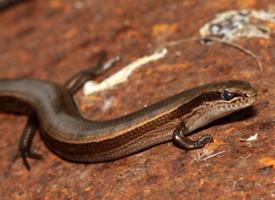
Váhy a míry
| Délka | od 6 do 11 cm |
|---|
Popis zvířete
The European copper skink, scientifically known as Ablepharus kitaibelii, is a fascinating species of skink that dwells predominantly in the varied terrains of southeastern Europe and extends its range into the Middle East. This species is notable for its distinctive physical and behavioral traits that make it a subject of interest among herpetologists and nature enthusiasts alike.Physically, the European copper skink is a small, slender lizard, typically reaching lengths of up to 15 centimeters, including its tail. Its body is streamlined, allowing for swift movement through its habitat, which is essential for escaping predators and hunting prey. The skin of this skink is smooth and glossy, with a color palette that usually blends beautifully with its natural surroundings. The dorsal side of the skink exhibits shades of brown or gray, often with a metallic copper sheen that gives the species its common name. This natural camouflage is crucial for its survival, helping it remain unnoticed by both predators and prey.
One of the most striking features of the European copper skink is its scales, which are small, overlapping, and shiny, contributing to its sleek appearance. The belly of the skink is typically lighter, ranging from cream to light pink, which contrasts with the darker dorsal side. The skink's eyes are alert and relatively large, with a characteristic eyelid feature that distinguishes it from many other lizards that have a more fixed membrane.
In terms of behavior, Ablepharus kitaibelii is a diurnal creature, most active during the daylight hours when it ventures out to feed and bask in the sun. Its diet primarily consists of small invertebrates, such as insects and spiders, which it hunts with precision and agility. The skink is also known for its secretive nature, often hiding under rocks, leaf litter, or in crevices when threatened or during the hottest parts of the day.
The habitat of the European copper skink is quite varied, encompassing rocky areas, grasslands, forests, and even human-altered landscapes like gardens and agricultural fields, provided that cover and food sources are available. This adaptability has allowed the species to survive in a range of environmental conditions, although it prefers areas with a certain level of humidity and access to hiding spots.
Reproduction in Ablepharus kitaibelii involves oviparity, meaning the skink lays eggs rather than giving birth to live young. The breeding season typically occurs in spring, with females laying clutches of eggs that they bury in moist soil or under debris. These eggs hatch after several weeks, revealing miniature versions of the adults that are independent from birth and must fend for themselves.
Despite its resilience and adaptability, the European copper skink faces threats from habitat destruction, pollution, and the pet trade. Conservation efforts are essential to ensure the survival of this species, including habitat preservation, research, and potentially regulating collection from the wild. Education and awareness can also play a key role in protecting the European copper skink and its environment, ensuring that future generations may continue to observe and appreciate this remarkable reptile.
Nové fotografie zvířat
Top 10 zvířat
- Diana monkey (Cercopithecus diana)
- Dolphin gull (Leucophaeus scoresbii)
- Moustached guenon (Cercopithecus cephus)
- Galápagos tortoise (Geochelone nigra complex)
- Japanese spider crab (Macrocheira kaempferi)
- Colossal squid (Mesonychoteuthis hamiltoni)
- Stone loach (Barbatula barbatula)
- Common house mosquito (Culex pipiens)
- Common reed warbler (Acrocephalus scirpaceus)
- Sea urchins (Echinoidea)